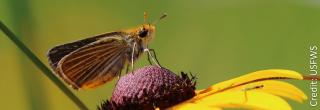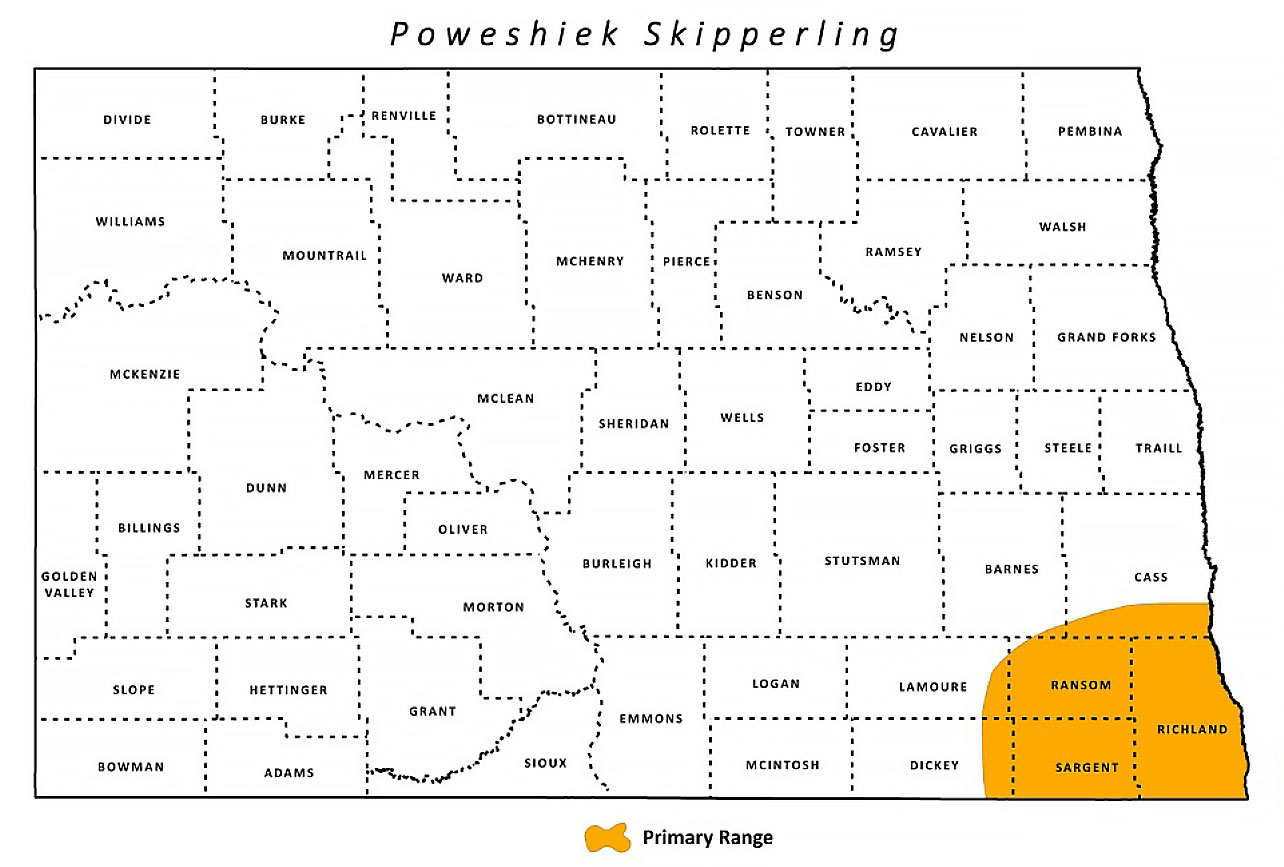

Poweshiek Skipperling
| Scientific Name | Oarisma poweshiek |
|---|---|
| General Description | Small butterfly measuring an inch in length. Its dorsal side is a dark brown with an orange head and wing margins. The undersides of the wings are lighter in color with prominent white veins. |
| Status | Resident |
| Abundance | Rare, believed extirpated. |
| Primary Habitat | Found in native tracts of tall and mixed grass prairie. Bluestem is indicative of the habitat. Purple Coneflower is often found in these sites as well. |
| Federal Status | Endangered. |
| Reason for Designation | Listed as Endangered by the USFWS. Loss of habitat is the driving concern. |
Locations and Conditions of Key Habitat
Preferred Habitat
Poweshiek Skipperling is found in high quality native grassland tracts. Preferred areas are considered wet-to-dry prairie with mesic hillsides near low moist areas within undisturbed habitat.
Key Areas and Conditions for Poweshiek Skipperling in North Dakota
The Poweshiek Skipperling is considered extirpated within North Dakota. Three sites have been proposed as critical habitat by the USFWS in Sargent and Richland counties.
Problems Which May Affect this Species
Habitat
The loss of native prairie is the primary cause for this species decline. Poweshiek Skipperling are also absent from native grasslands that are intensely grazed or often burned. Lack of management to suitable sites which allows encroachment of invasive species is also a problem. This species does not have the ability to move great distance so suitable sites may be absent of Dakota Skipper from lack of immigration from other populations.
Other Natural or Manmade Factors
The use of herbicide for weed control at certain times of the year in native prairie tracts may be a detriment by reducing nectar sources for the butterfly. Insecticide use near populations may also a factor.
Research and Survey Efforts
Current Research or Surveys
- The USFWS will continue to monitor previously occupied sites in North Dakota.
Previous Research or Surveys
- Most recently Royer surveyed 29 sites in North Dakota for Dakota Skipper and Poweshiek Skipperling.
- Royer et al originally surveyed above sites in 1992.
- Royer and Marrone developed a conservation status of the Poweshiek Skipperling for the USFWS in 1992.
Additional Research or Surveys Needed
- Training of additional biologists to identify and survey prairie butterflies is needed.
- Continued monitoring of potential sites for presence of Poweshiek Skipperling.
Management Recommendations
- Develop pollinator habitat.
- Protect and manage high quality native prairie.
- When using prescribed fire to manage do not burn entire area of know population. Use techniques to promote patchy burns. Burn prior to May 1 when possible.
- Delay haying of habitat until after end of adult flight. Leave 8 inches of structure to provide over-wintering cover. Do not hay entire occupied site each season when possible.
- Limit the duration and intensity of grazing in Dakota Skipper habitat. Do not graze habitat for entire season and manage for 8 inches of structure. Spring grazing is preferable. Avoid grazing of nectar sources during the flight period.
- Avoid broadcast spraying of pesticides and herbicides at known sites to minimize loss of adults and nectar sources.
- Monitor known inhabited sites.
Monitoring Plans
The North Dakota Game and Fish Department currently does not have a monitoring protocol for this species. Currently the Dakota Skipper is not known to occur on NDGFD managed lands. Should they be found, development of a protocol to monitor NDGFD managed lands would be necessary.
2005-2015 PROGRESS
The Poweshiek Skipperling was added as a Level II Species of Conservation Priority during the 2015 Wildlife Action Plan revision. A new SWG proposed with the University of North Dakota will look to develop a model to predict habitat suitable for this and other prairie obligate butterflies.

For more information about the poweshiek skipperling see the USFWS website.
Note: A listing of works consulted when compiling the information on this page may be found in the 2015 State Wildlife Action Plan.
